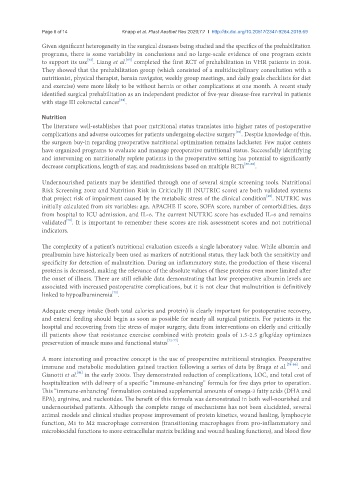Page 76 - Read Online
P. 76
Page 6 of 14 Knapp et al. Plast Aesthet Res 2020;7:7 I http://dx.doi.org/10.20517/2347-9264.2019.69
Given significant heterogeneity in the surgical diseases being studied and the specifics of the prehabilitation
programs, there is some variability in conclusions and no large-scale evidence of one program exists
[62]
[63]
to support its use . Liang et al. completed the first RCT of prehabilitation in VHR patients in 2018.
They showed that the prehabilitation group (which consisted of a multidisciplinary consultation with a
nutritionist, physical therapist, hernia navigator, weekly group meetings, and daily goals checklists for diet
and exercise) were more likely to be without hernia or other complications at one month. A recent study
identified surgical prehabilitation as an independent predictor of five-year disease-free survival in patients
[64]
with stage III colorectal cancer .
Nutrition
The literature well-establishes that poor nutritional status translates into higher rates of postoperative
[65]
complications and adverse outcomes for patients undergoing elective surgery . Despite knowledge of this,
the surgeon buy-in regarding preoperative nutritional optimization remains lackluster. Few major centers
have organized programs to evaluate and manage preoperative nutritional status. Successfully identifying
and intervening on nutritionally replete patients in the preoperative setting has potential to significantly
decrease complications, length of stay, and readmissions based on multiple RCTs [66-68] .
Undernourished patients may be identified through one of several simple screening tools. Nutritional
Risk Screening 2002 and Nutrition Risk in Critically Ill (NUTRIC score) are both validated systems
[69]
that project risk of impairment caused by the metabolic stress of the clinical condition . NUTRIC was
initially calculated from six variables: age, APACHE II score, SOFA score, number of comorbidities, days
from hospital to ICU admission, and IL-6. The current NUTRIC score has excluded IL-6 and remains
[70]
validated . It is important to remember these scores are risk assessment scores and not nutritional
indicators.
The complexity of a patient’s nutritional evaluation exceeds a single laboratory value. While albumin and
prealbumin have historically been used as markers of nutritional status, they lack both the sensitivity and
specificity for detection of malnutrition. During an inflammatory state, the production of these visceral
proteins is decreased, making the relevance of the absolute values of these proteins even more limited after
the onset of illness. There are still reliable data demonstrating that low preoperative albumin levels are
associated with increased postoperative complications, but it is not clear that malnutrition is definitively
[71]
linked to hypoalbuminemia .
Adequate energy intake (both total calories and protein) is clearly important for postoperative recovery,
and enteral feeding should begin as soon as possible for nearly all surgical patients. For patients in the
hospital and recovering from the stress of major surgery, data from interventions on elderly and critically
ill patients show that resistance exercise combined with protein goals of 1.5-2.5 g/kg/day optimizes
preservation of muscle mass and functional status [72-77] .
A more interesting and proactive concept is the use of preoperative nutritional strategies. Preoperative
immune and metabolic modulation gained traction following a series of data by Braga et al. [78-80] . and
[81]
Gianotti et al. in the early 2000s. They demonstrated reduction of complications, LOC, and total cost of
hospitalization with delivery of a specific “immune-enhancing” formula for five days prior to operation.
This “immune-enhancing” formulation contained supplemental amounts of omega-3 fatty acids (DHA and
EPA), arginine, and nucleotides. The benefit of this formula was demonstrated in both well-nourished and
undernourished patients. Although the complete range of mechanisms has not been elucidated, several
animal models and clinical studies propose improvement of protein kinetics, wound healing, lymphocyte
function, M1 to M2 macrophage conversion (transitioning macrophages from pro-inflammatory and
microbiocidal functions to more extracellular matrix building and wound healing functions), and blood flow

